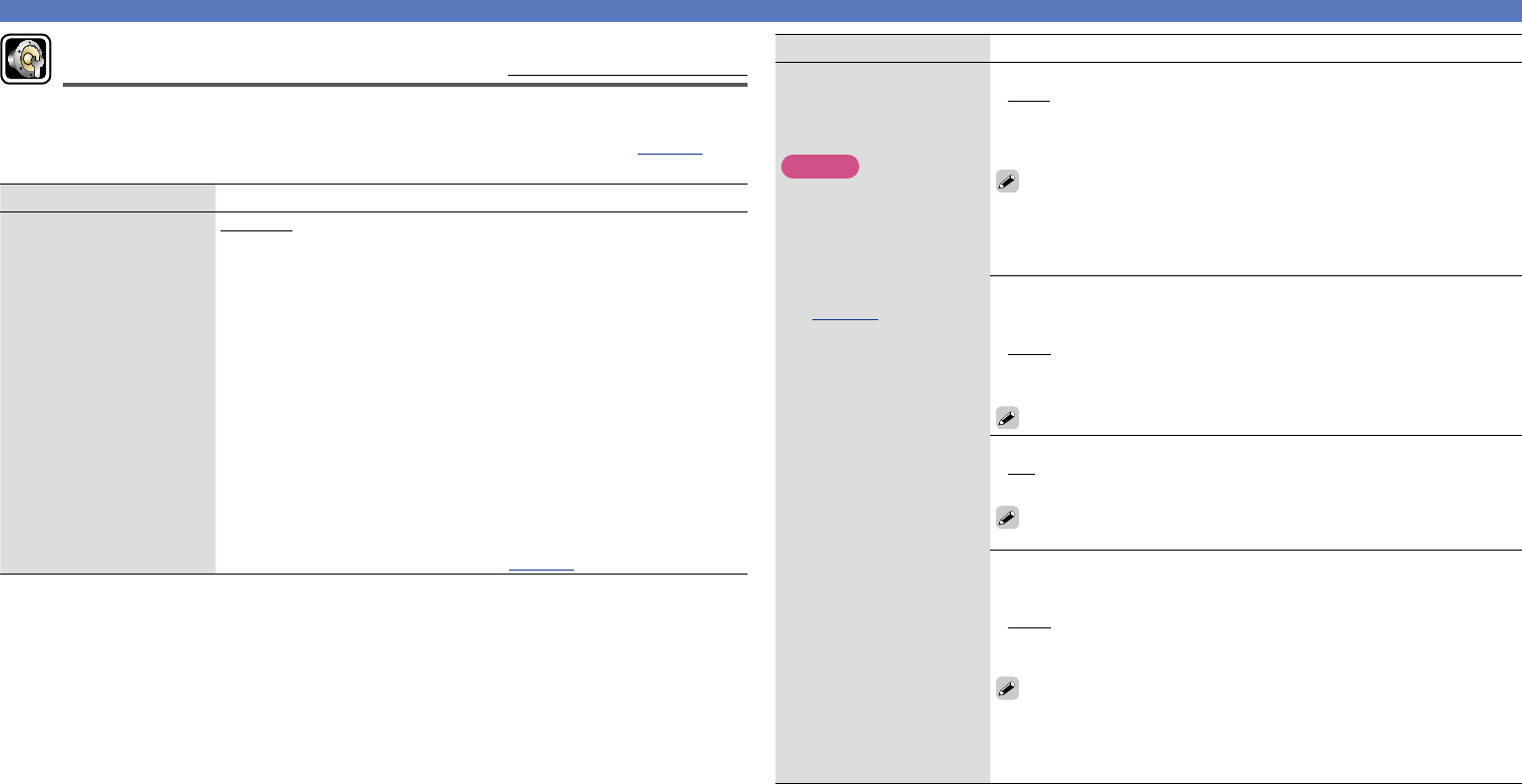
104
Speaker Setup
Default settings are underlined.
Perform when setting the speakers manually or when changing settings made in Audyssey
®
Auto Setup.
•If you change the speaker settings after performing Audyssey
®
Auto Setup, it will not be possible to select
Audyssey MultEQ
®
XT, Audyssey Dynamic EQ
®
and Audyssey Dynamic Volume
®
(vpage100).
•“SYSTEM SETUP” can be used without changing the settings. Please set if necessary.
Setting items Setting details
Amp Assign
The signal output from the
SURR.BACK/AMP ASSIGN
speaker terminal of this unit
can be switched to match
your speaker environment.
NORMAL : Select the “NORMAL” setting to perform 7.1-channel playback
using the surround back, front height, or front wide speakers.
ZONE2 : Select the “ZONE2” setting to assign the unit’s built-in power
amplifier for ZONE2 and output the audio in stereo.
ZONE3 : Select the “ZONE3” setting to assign the unit’s built-in power
amplifier for ZONE3 and output the audio in stereo.
Z2/Z3(M) : Select the “Z2/Z3(M)” setting to assign the unit’s built-in
power amplifier for ZONE2 and ZONE3 and output the audio in monaural.
Bi-AMP : Select the “Bi-AMP” setting to connect the front speakers via
the bi-amp connection.
2CH : When you perform 2-channel playback in the DIRECT or STEREO
mode, select the “2CH” setting to use the other front speakers for
playback.
Front B : Select the “Front B” setting to use the second set of front
speakers for playback. You can switch the front speakers A and B to be
used for playback in accordance with the 2-channel playback or multi-
channel playback mode. When you select this Front B setting, also
perform the “Front Speaker Setup” (vpage107) procedure.
SYSTEM SETUP
Setting items Setting details
Speaker Config.
Select speaker configuration
and size (bass reproduction
capability).
NOTE
Do not use the outward
shape of the speaker to
determine selection of a
“Large” or “Small” speaker.
Instead, use the frequencies
set in “Crossover Freq.”
(vpage107) as the
standard for determining
bass reproduction capability.
Front : Set the front speaker size.
•Large : Use a large speaker that can adequately play back low
frequencies.
•Small : Use a small speaker that has inadequate playback capacity for
low frequencies.
•When “Subwoofer” is set to “No”, “Front” is automatically set to
“Large”.
•When “Front” is set to “Small”, “Center”, “Surround“, “Surr.Back”,
“Front Height” and “Front Wide” can not be set to “Large”.
Center : Set the presence and size of the center speaker.
•Large : Use a large speaker that can adequately play back low
frequencies.
•Small : Use a small speaker that has inadequate playback capacity for
low frequencies.
•None : Select when a center speaker is not connected.
“Large” is not displayed when “Front” is set to “Small”.
Subwoofer : Set the presence of a subwoofer.
•Yes : Use a subwoofer.
•No : Select when a subwoofer is not connected.
When “Front” is set to “Small”, “Subwoofer” is automatically set to
“Yes”.
Surround : Set the presence and size of the surround speakers.
•Large : Use a large speaker that can adequately play back low
frequencies.
•Small : Use a small speaker that has inadequate playback capacity for
low frequencies.
•None : Select when the surround speakers are not connected.
•When “Surround” is set to “Large”, “Surr.Back”, “Front Height” and
“Front Wide” can be set to “Large”.
•When “Surround” is set to “None”, “Surr.Back”, “Front Height” and
“Front Wide” are automatically set to “None”.
Basic version
Advanced version
Information
Advanced version
vSee overleaf
BD


















